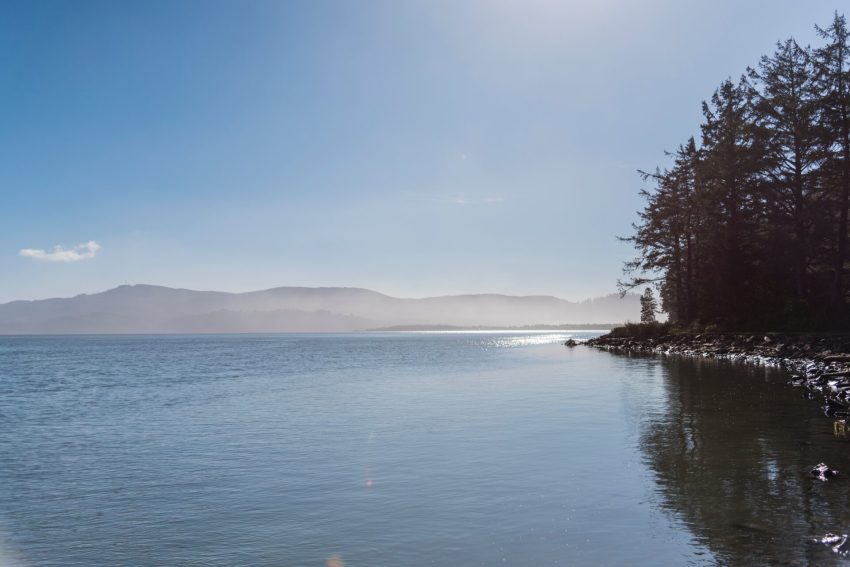Have you ever been out on Tillamook Bay and seen clumps of long thin green grass moving along with the tide? Have you walked on Cape Meares Spit beach and seen miles of piles of this same green grass? Have you been ocean fishing off of our coast and witnessed islands of grass lined up along tidal rips? If so, where do you think all that grass comes from? It comes from being systematically torn by its roots by mechanized oyster farming in Tillamook Bay and our own State Department of Agriculture is turning a blind eye to its destruction. Why is this important to you?
When it comes to estuaries, eelgrass is globally recognized as a keystone species of shallow water plant. So if you like the taste of Dungeness crab, the eelgrass harbors protection from predators and provides food for the juvenile crabs, that when mature, end up on your plate. You have five rivers flowing into your bay that provide salmon and steelhead for you to enjoy. Many of you have volunteered to help restore habitat up river with the goal of increasing numbers of returning adult fish. Young salmon and steelhead smolt need cover from predation to successfully complete their journey through the bay to the ocean to begin their migratory cycle. These youngsters have to run a gauntlet through cormorants, harbor seals, merganser ducks, otters, eagles, seagulls, Caspian turns and ospreys. Eelgrass provides thick forests of cover to help them on their way. Without eelgrass, the goals of riparian restoration efforts will not be met!
If you are a commercial fisherman targeting salmon, bottom fish, or crab, you depend on eelgrass to provide the food and cover for the young of the species you are targeting. The ocean is warming and acidifying. Eelgrass sequesters carbon and that helps mitigate both of these problems. Of particular concern to our local economy is the acidification because clams, oysters, and crabs have difficulty forming shell material as the ocean water acid level rises. And eelgrass helps to clean and filter the water of the myriad of pollutants leaching into the bay. Eelgrass anchors the bay bottom and slows wave action which aids in preventing storm damage along shorelines.
Have you talked to any old timers lately? They will share stories of how large schools of herring, anchovies, and sturgeon would come into the bay to spawn in areas of eelgrass. All this has disappeared. Why? The degradation of eelgrass beds is certainly a contributing factor.
Approximately 80% of our bay is being leased out to oyster farmers. The majority of the acreage being leased allows for mechanical means of ground preparation and harvest. This equates to the equivalent of a farm harrow being pulled across the bottom as preparation and toothed dredges being dragged across the bottom to harvest. This action results in the destruction of the eelgrass, as well as other bottom dwelling species, and is recognized globally as the most harmful means of aquaculture.
Recognizing its importance, there are currently fifty-seven different projects across the United States to replant eelgrass that has been destroyed by pollution, development, dredging, or poor oyster aquaculture methods. These expensive and time consuming efforts often fail because of lost bottom infrastructure. We must recognize the interconnectedness of environmental conservation and economic prosperity. A healthy bay drives commercial fishing, crabbing, clamming, and oyster businesses and their suppliers. Tourists with their boats travel here to fish and crab or hire professional fishing guides to take them out. Motels, restaurants, grocery stores, and gas stations all depend on the business generated from the bounty provided by our precious bay.
As citizens of the state and owners of the bay, we have a collective responsibility and a moral duty to preserve the bay’s natural heritage and safeguard the future of it for generations to come. Our State Department of Agriculture issues the lease permits. Is there a periodic public review process for these leases? Who is monitoring restrictions outlined in the leases? Why are they issuing lease permits that allow mechanized methods of aquaculture when there is such an abundance of evidence of its destructiveness?
We must urge the DOA to halt the approval of mechanical aquaculture methods. While oyster farming plays a significant role in our local economy, it must not come at the expense of our environment’s health and resilience. Now is the time to act to stop this needless damage. We should advocate for sustainable aquaculture practices that coexist harmoniously with eelgrass ecosystems. The majority of oyster farmers across the state utilize these methods. Repeated raking out the eelgrass will lead to its disappearance and if that happens we will all pay. Let us raise our voices in support of sustainable practices and demand accountability from those entrusted with managing our natural resources. What can you do? When ordering oysters, ask your fish monger or restaurant how they were farmed. Write your local state representatives and talk to your county commissioners. Together, we can ensure that Tillamook Bay remains a vibrant and resilient ecosystem, sustaining both nature and livelihoods for years to come.
Friends of Tillamook Bay
friendsoftillamookbay@gmail.com


